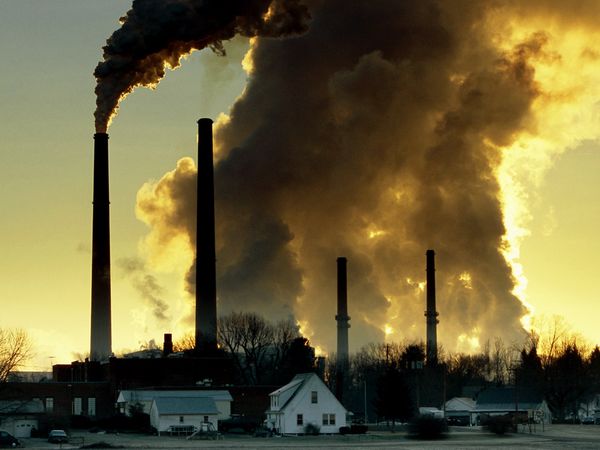Facts (comes from many sources)

Smog hanging over cities is the most familiar and obvious form of air pollution. But there are different kinds of pollution—some visible, some invisible—that contribute to global warming. Generally any substance that people introduce into the atmosphere that has damaging effects on living things and the environment is considered air pollution. |
|
Carbon dioxide, a greenhouse gas, is the main pollutant that is warming Earth. Though living things emit carbon dioxide when they breathe, carbon dioxide is widely considered to be a pollutant when associated with cars, planes, power plants, and other human activities that involve the burning of fossil fuels such as gasoline and natural gas. In the past 150 years, such activities have pumped enough carbon dioxide into the atmosphere to raise its levels higher than they have been for hundreds of thousands of years. |
|
Most people agree that to curb global warming, a variety of measures need to be taken. On a personal level, driving and flying less, recycling, and conservation reduces a person’s "carbon footprint"—the amount of carbon dioxide a person is responsible for putting into the atmosphere. On a larger scale, governments are taking measures to limit emissions of carbon dioxide and other greenhouse gases. One way is through the Kyoto Protocol, an agreement between countries that they will cut back on carbon dioxide emissions. Another method is to put taxes on carbon emissions or higher taxes on gasoline, so that people and companies will have greater incentives to conserve energy and pollute less. |
- Pollution is one of the biggest global killers, affecting over 100 million people. That’s comparable to global diseases like malaria and HIV.
- Over 1 billion people worldwide lack access to safe drinking water. 5,000 people die each day due to dirty drinking water.
- 14 billion pounds of garbage are dumped into the ocean every year. Most of it is plastic.
- Over 1 million seabirds and 100,000 sea mammals are killed by pollution every year.
- People who live in places with high levels of air pollutants have a 20% higher risk of death from lung cancer than people who live in less-polluted areas.
- The Mississippi River carries an estimated 1.5 million metric tons of nitrogen pollution into the Gulf of Mexico each year, creating a “dead zone” in the Gulf each summer about the size of New Jersey.
- Approximately 46% of the lakes in America are too polluted for fishing, aquatic life, or swimming.
- Americans make up an estimated 5% of the world’s population. However, the U.S. produces an estimated 30% of the world’s waste and uses 25% of the world’s resources.
- Each year 1.2 trillion gallons of untreated sewage, stormwater, and industrial waste are dumped into U.S. water.
- While children only make up 10% of the world’s population, over 40% of the global burden of disease falls on them. More than 3 million children under age five die annually from environmental factors.
- Recycling and composting prevented 85 million tons of material away from being disposed of in 2010, up from 18 million tons in 1980.
